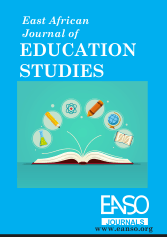The Relationship between the Availability of School Farms as an Instructional Resource and Agriculture Curriculum Implementation in Secondary Schools in Bureti Sub-County
Abstract
This study aimed to examine the relationship between the availability of instructional resources and the implementation of the agriculture curriculum in secondary schools in Bureti Sub-County, Kericho County. A descriptive survey research design was employed, targeting a population of 8,897 individuals, including 61 principals, 61 agriculture teachers, and 8,775 agriculture students across 61 public secondary schools. The accessible population included 1,830 agriculture students from form three, 61 principals, and 61 agriculture teachers. A sample of 328 agriculture students, 61 principals, and 61 teachers was selected using stratified proportionate and simple random sampling techniques. Data was collected using structured questionnaires for agriculture teachers, principals, and students. The results indicated that most schools (94.1%) had farms, though the majority (74.4%) had small farm sizes of 0.25 to 2.5 acres. This limited space may constrain the full practical implementation of the agriculture curriculum, which is crucial for effective learning. The farms were primarily used for crop production (66.7%) and teaching (33.3%), with smaller contributions to livestock and tree planting activities. Despite the small scale of many farms, agricultural teaching activities, particularly crop production and livestock management, were actively carried out. Both teachers and principals reported that the theoretical aspects of the syllabus were well covered, while the practical aspects were somewhat less comprehensive, with 23.5% of teachers and 25% of principals reporting challenges in fully covering practical elements. The Pearson correlation coefficient between the size of the school farm and the overall implementation of the agriculture curriculum was -0.380 (p-value = 0.180), indicating a weak negative correlation. While the small size of school farms posed challenges in implementing practical elements of the curriculum, the study suggests the need for more expansive resources to enhance curriculum delivery. Recommendations include increasing farm size and improving resource allocation to support both theoretical and practical teaching.
Downloads
References
Aholi, S. S., Konyango, J. J. J., &Kibett, J. K. (2018). Influence of Instructional Resources in Learning Agriculture in Secondary School on Employment Creation in Vihiga County, Kenya. International Journal of Educational Administration and Policy Studies, 10(1), 1–9.
Deming, J., Macken-Walsh, Á., O’Brien, B., & Kinsella, J. (2019). Entering the occupational category of ‘Farmer’: New pathways through professional agricultural education in Ireland. The Journal of Agricultural Education and Extension, 25(1), 63–78.
Karani, A., Kyule, M., &Ng’eno, J. (2024). The Extent of Inculcating Competencies In Teaching Competence-Based Grade Four Agriculture Among Public Primary Schools In Njoro Sub-County of Kenya. International Journal of Education, Technology and Science, 4(1), 1736–1759.
Karani, A., Miriam, K., & Mironga, J. (2021). Teaching competence-based agriculture subject in primary schools in Kenya; a Review of Institutional Preparedness. International Journal of Education, Technology and Science, 1(1), 14–30.
Kenya National Bureau of Statistics (KNBS). (2019). 2019 Kenya Population and Housing Census: Volume IV.
Kicd.ac.ke. (2020). The Secondary School Curriculum: Kenya Institute of Curriculum Development
Konyango, J., &Asienyo, B. O. (2015). Secondary school agriculture: Participatory approaches to the implementation of secondary school agriculture curriculum in Kenya between1959 and 2012. International Journal of Scientific Research and Innovative Technology, 2(1), 1–11.
Konyango, J. J., &Asienyo, B. O. (2018). Secondary School Agriculture Curriculum Reforms in Kenya 1959-2016: Challenges to Innovations.
Kumar, R. (2019). Research Methodology: A Step-by-Step Guide for Beginners (Vol. 4). Sage Publications Limited.
Lambert et al. (2018). Collecting and delivering progress feedback: A meta-analysis of routine outcome monitoring.
Livingstone, D. W. (2018). The Education-Jobs Gap: Underemployment or Economic Democracy? Routledge.
Machisu, V., Opondo, V., Nakhumicha, A., & Mosi, R. O. (2022). Influence of school agricultural farms on academic performance in agriculture in secondary schools. Journal of Agriculture, Science and Technology, 21(3), 49-60.
Makoye, S. (2014). Assessment of students’ academic performance under secondary education development plan (SEDP I) implementation: the case of Nyamagana district, Tanzania (Doctoral dissertation, Sokoine University of Agriculture).
Manyasi, A. N. (2019). Contribution Of Women Graduates Of Secondary School Agriculture Subject To Agricultural Productivity In Navakholo, Kakamega County, Kenya. Mmust.
Moore, G. E. (2017). The status of agricultural education prior to the Smith-Hughes Act. The Agricultural Education Magazine, 89(4), 21.
Mulinya, L. C., &Orodho, J. A. (2015). Free Primary Education Policy: Coping Strategies in Public Primary Schools in Kakamega South District, Kakamega County, Kenya. Journal of Education and Practice, 6(12), 162–172.
Mutegi, J. K., Jama, B. A., Silim, S., & Ameru, J. N. (2014). Potential of grain legume fallows to address food insecurity and boost household incomes in western Kenya. International Journal of Development Research, 4(5), 1154-1161.
Nilson, L. B. (2016). Teaching at its best: A research-based resource for college instructors. John Wiley & Sons.
Nyagah, G. (2019). Influence of Facilities on Performance in Prevocational Subjects in the 8-4-4 Education System: Lessons for the Proposed Competence Based Curriculum in Kenya.
Ongaga et al (2020). High School Diversity Clubs: Advisor Qualifications, Resources, and Curriculum. The High School Journal 104(1), 54-74.
Onwumere, M., Modebelu, M. N., &Chukwuka, I. E. (2016). Influence of school farm on teaching of agricultural science in Senior Secondary Schools in Ikwuano Local Government Area, Abia State. Open Access Library Journal, 3(06), 1.
Onyendi, H. U. (2022). Trade Growth and Economic Development in Developing Economies: Evidence from Nigeria. Social Science Research, 7(2)
Pillay, N. (2022). Exploring the Challenges and Opportunities of Farm School Infrastructure in Kwa-Zulu Natal, South Africa. Mobility, Knowledge and Innovation Hubs in Urban and Regional Development. Proceedings of REAL CORP, 323–330.
Prescott, M. P., Cleary, R., Bonanno, A., Costanigro, M., Jablonski, B. B., & Long, A. B. (2020). Farm to school activities and student outcomes: A systematic review. Advances in Nutrition, 11(2), 357–374.
Rehman, A., Jingdong, L., Khatoon, R., Hussain, I., & Iqbal, M. S. (2016). Modern agricultural technology adoption its importance, role and usage for the improvement of agriculture. Life Science Journal, 14(2), 70–74.
Copyright (c) 2025 Margaret Chesang Byomndo, Shadrack Cheplogoi, PhD, Jacob J.J.O. Konyango, PhD

This work is licensed under a Creative Commons Attribution 4.0 International License.




























